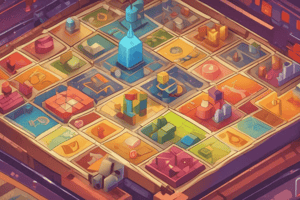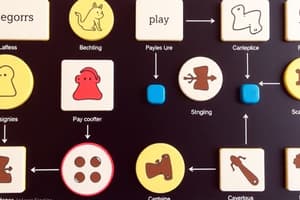Podcast
Questions and Answers
According to the theorist Roger Caillois, what is the primary distinction between 'play' and 'game'?
According to the theorist Roger Caillois, what is the primary distinction between 'play' and 'game'?
- Play is always competitive, while games are cooperative.
- Play involves physical activity, while games are predominantly mental.
- Play lacks defined structure or goals, while games have rules and set objectives. (correct)
- Play is primarily for children, while games are for adults.
Which characteristic distinguishes professional sports from 'play,' according to the content?
Which characteristic distinguishes professional sports from 'play,' according to the content?
- Professional sports are driven by profit and obligation, unlike the freedom of play. (correct)
- Professional sports require more physical exertion.
- Professional sports are structured by rules and regulations.
- Professional sports involve teamwork and strategy.
How do board game to video game 'ports' relate to the concepts of 'play' and 'game'?
How do board game to video game 'ports' relate to the concepts of 'play' and 'game'?
- They demonstrate how games can be adapted across different mediums while maintaining their core structure. (correct)
- They represent a shift from structured games to unstructured play.
- They illustrate the diminishing quality of modern games compared to traditional play.
- They combine the defined rules of games with the freedom of play.
Which of the following best describes the essence of 'school yard' games like 'Duck, Duck, Goose' and 'Hide and Seek' in the context of play and game?
Which of the following best describes the essence of 'school yard' games like 'Duck, Duck, Goose' and 'Hide and Seek' in the context of play and game?
Considering the examples provided, what is a common feature that classifies card games, table-top games and video games as 'games' rather than 'play'?
Considering the examples provided, what is a common feature that classifies card games, table-top games and video games as 'games' rather than 'play'?
How do definitions of games influence the games we create and play?
How do definitions of games influence the games we create and play?
Why was Gone Home (2013) a significant title in the 'game/not a game' debate?
Why was Gone Home (2013) a significant title in the 'game/not a game' debate?
What is a 'walking simulator,' and why is the term sometimes used pejoratively?
What is a 'walking simulator,' and why is the term sometimes used pejoratively?
According to the content, what is a fundamental element of 'play'?
According to the content, what is a fundamental element of 'play'?
How did George Herbert Mead theorize that play contributes to a child's development?
How did George Herbert Mead theorize that play contributes to a child's development?
What was Johan Huizinga's main argument regarding play in his landmark book?
What was Johan Huizinga's main argument regarding play in his landmark book?
Which of the following is an example of how play can develop intellectual capacity?
Which of the following is an example of how play can develop intellectual capacity?
How does play instill basic social cues?
How does play instill basic social cues?
Which of the following best exemplifies 'pure play' within a video game environment?
Which of the following best exemplifies 'pure play' within a video game environment?
Which game mechanic exemplifies the principle of being related to game goals AND providing pure play?
Which game mechanic exemplifies the principle of being related to game goals AND providing pure play?
A game developer adds destructible elements to the environment. What design principle aligns with players choosing to interact with these elements simply to cause destruction?
A game developer adds destructible elements to the environment. What design principle aligns with players choosing to interact with these elements simply to cause destruction?
A game designer wants to incorporate 'deliberate jank' into their game. Which existing game would be a good example for them to study?
A game designer wants to incorporate 'deliberate jank' into their game. Which existing game would be a good example for them to study?
In the context of game design, how does 'pure play' exploration differ from typical exploration driven by game objectives?
In the context of game design, how does 'pure play' exploration differ from typical exploration driven by game objectives?
In the context of game design, what is the primary appeal of including non-essential interactive objects?
In the context of game design, what is the primary appeal of including non-essential interactive objects?
Which one of the following actions would be the best example of 'pure play' within the category of Human/Animal Interaction in a video game?
Which one of the following actions would be the best example of 'pure play' within the category of Human/Animal Interaction in a video game?
A game features a robust in-game photography system, allowing players to take and share pictures. When does this feature qualify as 'pure play'?
A game features a robust in-game photography system, allowing players to take and share pictures. When does this feature qualify as 'pure play'?
A game features a character who can meow, scratch furniture, and play with toys, similar to Stray. What design principle does this exemplify?
A game features a character who can meow, scratch furniture, and play with toys, similar to Stray. What design principle does this exemplify?
Which of the following describes an element of 'involuntary movement' in a video game?
Which of the following describes an element of 'involuntary movement' in a video game?
How can the inclusion of a seemingly mundane object like a flushable toilet contribute positively to a game's overall experience?
How can the inclusion of a seemingly mundane object like a flushable toilet contribute positively to a game's overall experience?
Which activity falls under the category of 'object manipulation' within the context of game design?
Which activity falls under the category of 'object manipulation' within the context of game design?
A game designer is creating loading screens. Inspired by Fallout 4, what could they include to enhance player engagement during loading?
A game designer is creating loading screens. Inspired by Fallout 4, what could they include to enhance player engagement during loading?
According to Jesper Juul's game model, what are the defining characteristics of a game?
According to Jesper Juul's game model, what are the defining characteristics of a game?
How does the game Gone Home fit into Jesper Juul's game model?
How does the game Gone Home fit into Jesper Juul's game model?
Applying Jesper Juul's game model, which element is most debatable as a 'fixed rule' in Gone Home?
Applying Jesper Juul's game model, which element is most debatable as a 'fixed rule' in Gone Home?
What is the primary purpose of 'pure play' elements in game design?
What is the primary purpose of 'pure play' elements in game design?
What does effective game design achieve by mixing 'game' and 'pure play'?
What does effective game design achieve by mixing 'game' and 'pure play'?
Which of the following best describes the primary function of mini-games within a larger video game?
Which of the following best describes the primary function of mini-games within a larger video game?
A game designer incorporates a climbing mechanic in their open-world game, allowing players to scale any building. How would this be categorized under 'pure play' if the players often climb without a specific objective?
A game designer incorporates a climbing mechanic in their open-world game, allowing players to scale any building. How would this be categorized under 'pure play' if the players often climb without a specific objective?
How can real-world games influence video game design, as evidenced by examples in the provided text?
How can real-world games influence video game design, as evidenced by examples in the provided text?
In the context of game design, if a player consistently uses a grappling hook to move around the game world even when faster travel options are available, what category of 'pure play' does this exemplify?
In the context of game design, if a player consistently uses a grappling hook to move around the game world even when faster travel options are available, what category of 'pure play' does this exemplify?
A game developer wants to add engaging mini-games to their open-world adventure. Which approach would best leverage the definition and examples of mini-games provided?
A game developer wants to add engaging mini-games to their open-world adventure. Which approach would best leverage the definition and examples of mini-games provided?
Flashcards
Definition of a Game
Definition of a Game
A game is an activity with rules, objectives, and player interaction, often involving fun.
Importance of Definitions in Gaming
Importance of Definitions in Gaming
Definitions shape the style, innovation, and expectations in game design and play.
Walking Simulators
Walking Simulators
Games requiring little interaction or mechanics, often criticized for lack of traditional gameplay.
Gone Home Case Study
Gone Home Case Study
Signup and view all the flashcards
What is Play?
What is Play?
Signup and view all the flashcards
Significance of Play
Significance of Play
Signup and view all the flashcards
George Herbert Mead on Play
George Herbert Mead on Play
Signup and view all the flashcards
Johan Huizinga's Contribution
Johan Huizinga's Contribution
Signup and view all the flashcards
Play
Play
Signup and view all the flashcards
Game
Game
Signup and view all the flashcards
Difference between Play and Game
Difference between Play and Game
Signup and view all the flashcards
Examples of Games
Examples of Games
Signup and view all the flashcards
Roger Caillois
Roger Caillois
Signup and view all the flashcards
Mini-Game
Mini-Game
Signup and view all the flashcards
Pure Play
Pure Play
Signup and view all the flashcards
Movement: Voluntary
Movement: Voluntary
Signup and view all the flashcards
Game Adaptations
Game Adaptations
Signup and view all the flashcards
Internal Card Games
Internal Card Games
Signup and view all the flashcards
Breakable Environments
Breakable Environments
Signup and view all the flashcards
Projectiles in Play
Projectiles in Play
Signup and view all the flashcards
Exploration in Games
Exploration in Games
Signup and view all the flashcards
Creativity in Gaming
Creativity in Gaming
Signup and view all the flashcards
Human/Animal Interaction
Human/Animal Interaction
Signup and view all the flashcards
Juul’s Classic Game Model
Juul’s Classic Game Model
Signup and view all the flashcards
Player Effort in Games
Player Effort in Games
Signup and view all the flashcards
Variable and Quantifiable Outcomes
Variable and Quantifiable Outcomes
Signup and view all the flashcards
Fixed Rules in Gaming
Fixed Rules in Gaming
Signup and view all the flashcards
Involuntary Movement
Involuntary Movement
Signup and view all the flashcards
Types of Involuntary Movement
Types of Involuntary Movement
Signup and view all the flashcards
Object Manipulation
Object Manipulation
Signup and view all the flashcards
Fun with Mechanics
Fun with Mechanics
Signup and view all the flashcards
Non-essential Interactive Objects
Non-essential Interactive Objects
Signup and view all the flashcards
Game Design Purpose
Game Design Purpose
Signup and view all the flashcards
Interactivity in Games
Interactivity in Games
Signup and view all the flashcards
Study Notes
What is a Game? What is Play? Why Should You Care?
- Examination of game design, creativity, immersion, minigames, and walking simulators.
- Definitions influence game style and conventions (for better or worse).
- Limiting definitions can stifle innovation, while expanding definitions can broaden the scope.
- This applies to other art forms, such as music.
- Defining "game" impacts innovation and expectations.
Gone Home (2013): A Case Study
- Subtitled "A story exploration video game."
- Kicks off the whole "game/not a game/walking simulator" debate.
- Universally praised by major and minor gaming publications.
- Universally criticized by many gamers for not being a "true video game."
"Walking Simulators"
- Pejorative descriptor for games requiring little player interaction or with few mechanics.
- Popularized in 2013.
- A narrow-minded approach to video games and game design.
Play Defined (again)
- Play is an activity considered enjoyable or "fun."
- Play can be repetitive.
- It lacks a defined structure or end goal beyond simple enjoyment.
- Play must be voluntary. Players can't be forced to have fun.
George Herbert Mead (1863-1961)
- Social psychologist.
- Theorized that children develop self through stages: imitation, play, game, generalized other.
- Claimed play is essential to the development of self through make-believe and role-playing.
Johan Huizinga (1872-1945)
- Published a landmark book in 1938 examining play's importance.
- Concluded that play is intrinsic to many species (not just humans) and an essential element to culture.
- Play is free and untethered by material interests or profit.
Play is Instinctual: Innate
- Animals engage in crazy behaviors with no apparent purpose other than fun (e.g., otters).
- Sometimes, animal play mimics real-life actions like hunting. In other cases it's pure, spontaneous fun.
Roger Caillois (1913-1978)
- Theorist who categorized play and game on a spectrum.
- Play involves voluntary, enjoyable activity with no defined structure or end goal.
- Games are structured activities with defined rules and a set goal.
Examples of Game: SPORTS
- Any sport, by definition, includes rules, goals, and consequences.
- Pro sports are more akin to work because the goal is often profit.
Examples of Game: SPORTS Video Games
- Rich history of titles; remember EA's slogan "If it's in the game, it's in the game?"
- Madden NFL is a highly popular and consistent best-selling title.
- EA-FIFA used to be big, but there were rights issues that dissolved in 2022.
Examples of Game: TABLE-TOP GAMES
- Board games have rules, goals, and consequences.
- Board game to video game ports exist, but with variable quality.
- Some examples include famous games like Ticket to Ride and Gloomhaven.
Examples of Game: CARD GAMES
- Card games contain rules, goals, and consequences.
- Microsoft Solitaire is extremely popular.
- Examples of games in the Deck-Building genre are Hearthstone, Slay The Spire, Marvel Snap, Gwent. Balatro (a newer indie game from 2024) was nominated for game of the year.
Examples of Game: "SCHOOL YARD" GAMES
- These are casual games including Hide and Seek, Duck Duck Goose, Red Rover, Rock Paper Scissors, X's and O's, 7 Up, Hot Potato, Dodgeball, and Tag.
Examples of Game: Party, Bar, and Other
- Includes games like Bowling, Darts, Billiards, Laser Tag, Capture the Flag, The Floor is Lava, Ping Pong, Tabletop games, Pin the Tail on the Donkey, Spin the bottle, and drinking games.
The Point? Regarding GAME DESIGN
- Real-world games are often adapted into video games.
- The categories and games are not exclusive and often intersect.
The Mini-Game: A Definition
- A smaller game within the main video game.
- Can act as a digression (arcade machines) or world-building.
- Considered in games like GWENT, Chocobo Racing in FF7, shooting gallery in RE4, GTA V, Bioshock, and many others.
Stray (2022): Case Study
- Cat-as-player can interact with the environment and other characters (independently from game objectives)
Consider BREAKABLE ENVIRONMENTS
- The act of breaking objects is a form of pure play; it's not always about game goals. Common examples include Zelda, Dark Souls, Hollow Knight, and others.
Consider PROJECTILES
- Throwing projectiles (e.g., Kratos' axe, Cappy, Mario's items) provides pure play elements beyond the immediate game purpose.
CATEGORY 3: EXPLORATION
- Exploring is a pure enjoyment of the environment and is not usually related to side quests or game goals. Often involves avoiding fast travel for added immersion.
CATEGORY 4: CREATIVITY
- Examples include playing in a sandbox, with cardboard boxes, in the bathtub, in snow or with play-doh. Other examples that involve constructing a home, growing a garden, building forts or structures, using musical instruments, taking photos, or even taking selfies in various locations.
CATEGORY 5: Human/Animal INTERACTION
- Games based on interacting with animals and/or NPCs that are unrelated to game goals, like playing with pets/animals, playing with a baby, LARP, or any type of role play, without rules. Consider games that allow tormenting NPCs for pure fun.
Heck, consider House House's Untitled Goose Game (2019)
- Features a character meant purely to annoy other NPCs without gameplay goals.
Category 5: Human/Animal INTERACTION (continued)
- Examples include the ability to torment NPCs out of entertainment value; examples include Dragon Shout and even petting animals in Assassin's Creed.
The Last of Us 2
- Exploring the game world and pure play concepts are integrated, from space helmets to make-up and other features that enhance exploration.
Jesper Juul
- Professor at the University of Copenhagen.
- Developed the "Classic Game Model" to define games.
- Emphasizes the role of player effort and attachment in defining a game.
Juul's Model
- Explains how games and non-game elements can overlap in design and experience.
Conclusion One: Is Gone Home a Game?
- Yes, Gone Home is considered a game because it requires player effort, players need to actively participate and engage with the environment. There is also an outcome to discover and achieve.
Conclusion Two: Why Pure Play?
- Pure play categories focus on world-building, immersing the player in the game world; It's about activities that go beyond the immediate game objectives.
Epilogue: What Does The Developer Say?
- Developer perspective on the nature of Gone Home as a game, especially given it's a narrative-focused rather than traditional mechanics-based experience.
Additional Notes
- All games or activities could have elements of both game and pure play, not necessarily exclusive.
Studying That Suits You
Use AI to generate personalized quizzes and flashcards to suit your learning preferences.






